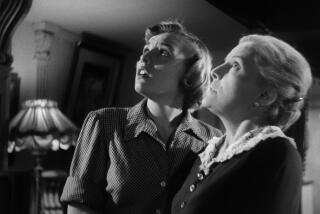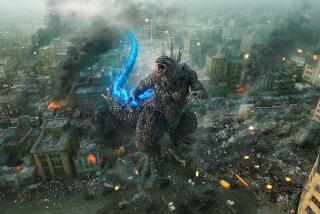‘Bambi’ returns, fresh as a flower
It took 14 months and 9,500 hours to restore and preserve all 110,000 frames of Walt Disney’s classic 1942 animated film, “Bambi,” the company says, and the end result comes out today on a two-disc DVD ($30).
“This is the first of a major corporate initiative to do film restoration at the studio,” says Disney animation director Dave Bossert, who served as artistic supervisor for the “Bambi” restoration.
The studio initiative, Bossert adds, “is about commerce to some degree, but it is about preserving artwork. For me, I equated this process to lying on your back on the scaffolding at the Sistine Chapel with a Q-tip taking centuries of dirt off a fresco. To me it is the same thing. ‘Bambi’ is a work of art.”
One of Disney’s greatest animated movies, “Bambi,” adapted from Felix Salten’s novel, focuses on the natural cycle of a young deer from his birth and adolescence through the birth of his own two fawns. Besides Bambi, who is destined to become the prince of the forest, the beloved characters include the funny bunny Thumper, the shy skunk Flower and the spirited fawn Faline who wins Bambi’s heart.
Disney’s animators, including the legendary Frank Thomas and Ollie Johnston, spent three years working on the film that elevated the art of animation with beautiful impressionistic watercolor backgrounds, realistically rendered animals and endearing characters.
Andreas Deja, a Disney animator who has brought such characters as Scar from “The Lion King” to life on screen, says the contemporary animators look upon the film with a sense of “awe.”
“It is one of those films that has a very, very simple story. They focused on a very simple outline, and that gave animators a chance to really let the characters breathe and deal with each other and also have them come up with a sequence like Bambi and Thumper on the ice. It’s totally character driven,” Deja says.
Deja admits he was “curious how they would handle the restoration. I think there is a danger of over-restoring a film.”
The TV ads and press materials do say the film is coming to “life as never before.” But Bossert says that honoring the animators’ original vision was the primary goal of the restoration.
“When they made the movie they did the best job they possibly could with the best technology at hand,” he says. “But there were some issues. It wasn’t their artistic intent to photograph dust into each frame. If they had had their way there wouldn’t be any dust or dirt in the frame. We didn’t set out to ‘change or improve’ the movie. What we set out to do was a restoration and a preservation.”
The restoration team first received the original nitrate negative of “Bambi,” which is stored in the film vaults at the Library of Congress. Nitrate is a highly combustible, unstable material that disintegrates over time. The “Bambi” negative was in surprisingly good condition “because of the care that has been given to it over the years,” Bossert says.
The original negative was cleaned, and then each frame was scanned at a 4,000-by-3,000 pixels-per-square-inch resolution. “You are basically getting all the information you can ever get,” Bossert says. “A 2,000 image is typically what you see on a movie screen.”
Those high-resolution scans were archived. “Then we took duplicate files and went through our entire restoration process on those digital films. At the end of that we not only archived those digital images, we also dropped out a new negative.”
To make sure the color correction was properly done, the animation team went to the studio’s animation research library, which is home to 70 million pieces of artwork.
“We were able to go to the ‘Bambi’ backgrounds. We had enough color background to represent the color palette of the movie. We basically walked in the footsteps of the original artists to get the original color back.”
The soundtrack is being offered in the original mono and a home theater stereo mix.
“The soundtrack was OK,” Bossert says. “With the digital technology you can take those soundtracks and get rid of the hisses and pops. We are fortunate that Terry Porter, a sound engineer at the studio, took a stab at trying something new. He was able to pull some of the soundtracks apart digitally” -- separating the music, sound effects and dialogue -- “and push them out into surround speakers a bit. It didn’t change the intent, but it is a fuller, lusher sound. I think that today’s audience is used to that. We kept the mono track because we didn’t want to neglect the aficionado.”
Also new this week:
“The SpongeBob SquarePants Movie” (Paramount, $30): Nickelodeon’s enormously popular animated series gets the big-screen treatment in this goofy comedy in which SpongeBob and his best friend, Patrick the starfish, must rescue the lost crown of King Neptune. Extras, including mini-documentaries, are passable but predictable.
“Incident at Loch Ness” (MGM, $28): Director Zak Penn and German director Werner Herzog star in this clever film-within-a-film mockumentary. Penn and Herzog offer amusing commentary.
“Piccadilly” (Milestone Film & Video, $30): The legendary Anna May Wong stars in this neglected 1929 British gem that was recently restored by the British Film Institute. Wong plays an ambitious scullery maid at a popular British nightclub who becomes a famed dancer there. Directed by E.A. Dupont, the silent film also features Cyril Ritchard of “Peter Pan” fame and Charles Laughton in his first screen appearance
“My Own Private Idaho” (Criterion $40): Two-disc set of Gus Van Sant’s 1991 film about a group of young male hustlers in Portland, Ore. -- a loose retelling of Shakespeare’s “Henry IV.” River Phoenix and Keanu Reeves star. The “director approved” special edition includes a comprehensive new documentary on the making of the film; a rather dull interview with film critic Paul Arthur, who discusses the Shakespearean influences; a conversation between the film’s producer Laurie Parker and the late Phoenix’s sister Rain; and an audio chat between Van Sant and director Todd Haynes.
“The River” (Criterion, $30): Jean Renoir’s first film in Technicolor, this 1951 adaptation of Rumer Godden’s coming-of-age novel is a beautifully wrought drama. The DVD includes a vintage introduction by the gregarious Renoir, a new interview with Martin Scorsese, who helped fund the restoration, and a fascinating 1995 documentary, “Rumer Godden: An Indian Affair.”
“Exorcist -- The Beginning” (Warner, $28): Prequel to the classic 1973 horror film was actually made twice: once by director Paul Schrader and then, after the studio deemed it not scary enough, Renny Harlin was hired to reshoot the film. The DVD features only Harlin’s version with no mention of Schrader.
“Flight of the Phoenix” (Fox, $30): This remake of the popular 1965 action-adventure stars Dennis Quaid, Miranda Otto and Hugh Laurie. Extras are unremarkable.
*
(BEGIN TEXT OF INFOBOX)
DVD sales
The top 10 DVDs in sales for the weekly period ending Feb. 20 represent a broad array of genres: horror, thriller, romance, biopic, animated and live action comedy, and science fiction. “Saw,” the surprise hit thriller from Lions Gate, occupies the No. 1 and 10 slots, in widescreen (letterbox) and full-screen versions. Rankings are compiled from a variety of major retailers, including Amazon.com, Best Buy, Blockbuster and Circuit City.
1. “Saw” (wide)
2. “The Notebook”
3. “Shark Tale” (wide)
4. “Ray” (wide)
5. “Taxi” (wide)
6. “Napoleon Dynamite”
7. “The Grudge”
8. “Shall We Dance” (wide)
9. “Alien vs. Predator” (wide)
10. “Saw” (full)
*
Source: DVDExclusive.com
More to Read
Only good movies
Get the Indie Focus newsletter, Mark Olsen's weekly guide to the world of cinema.
You may occasionally receive promotional content from the Los Angeles Times.











